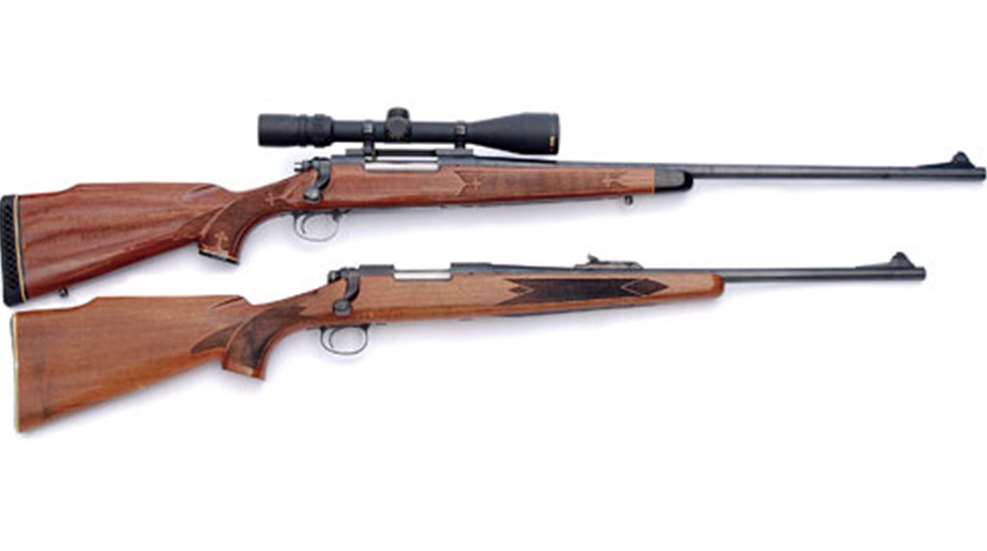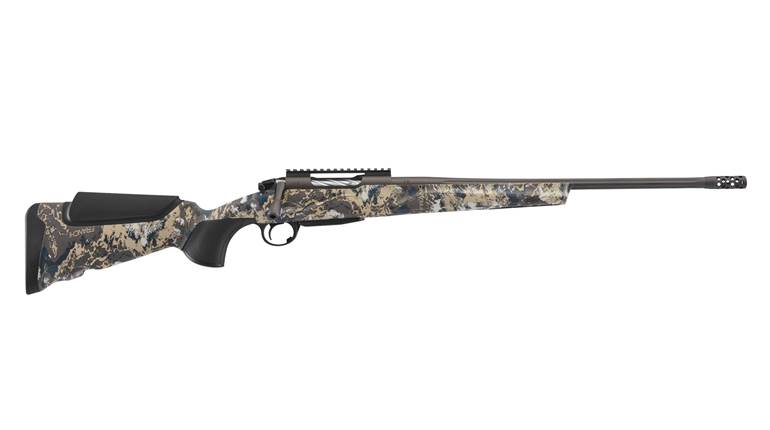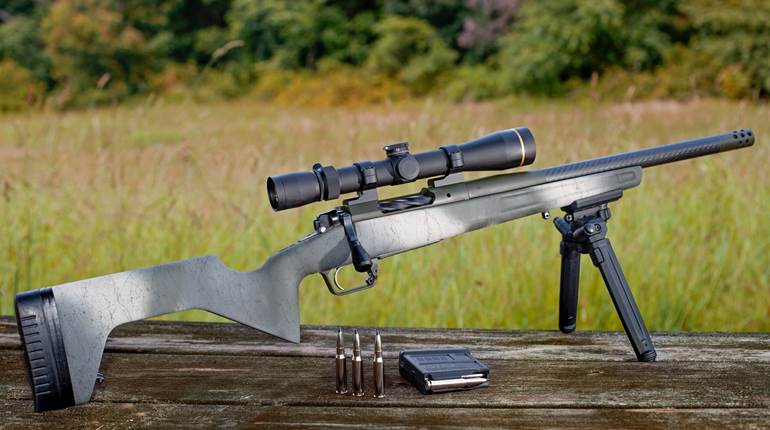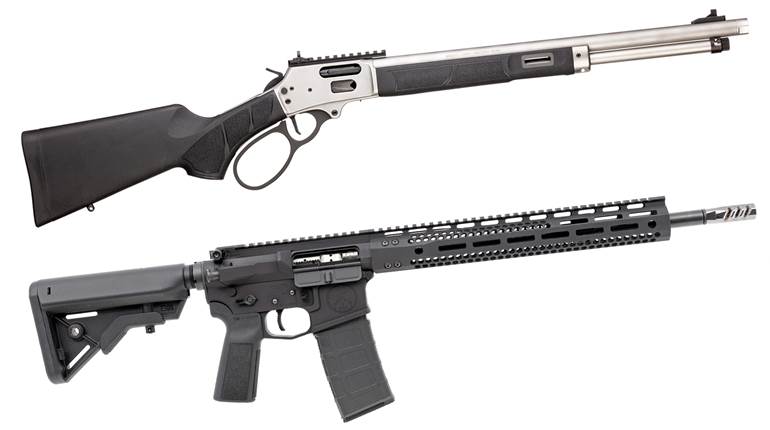
11/30/2012
Basically a modified version of the earlier Model 721, the Remington Model 700 was designed by a team of engineers headed by Mike Walker. Its first advertisement appeared in the June 1962 issue of American Rifleman. The new rifle was offered in short- and long-action versions and in two grades. The ADL had a blind magazine while the more expensive BDL had a hinged floorplate, black grip cap and forearm tip and more checkering coverage. It also came with a nice leather sling in quick-detachable swivels. Introductory prices for standard calibers were $114.95 for the ADL and $139.95 for the BDL. Prices for magnum versions of the BDL were $154.95 for the .264 Win. Mag., 7 mm Rem. Mag and .300 Win. Mag. and $310 for the .375 H&H Mag. and .458 Win. Mag. At the time the Winchester Model 70 in standard calibers sold for $139.
Hand-cutting checkering into a walnut stock was quite time-consuming so to reduce production cost, special tools were used to press the checkering into the surfaces of the Model 700’s grip and fore-end. From a distance it looked like any other checkering applied in an attractive fleur-de-lis pattern, but closer examination revealed each tiny diamond pointing inward—rather than outward as is the case for cut checkering. The new stock was also clad in what Remington advertisements described as the “RKW Bowling Pin Finish” and since DuPont had actually developed it as a near indestructible finish for use on bowling pins, it lived up to its name. While it might not be considered pretty by today’s standards, it was tougher than nails and much better than an oil finish at preventing entry of moisture into the stock. I bought a Model 700 BDL in 7 mm Rem. Mag. soon after it came out in 1962 and not once during 50 years of hunting has it lost zero.
Barrel lengths varied among the chamberings. Rifles in .375 H&H Mag. and .458 Win. Mag. had 26-inch barrels while those in .222 Rem., .222 Rem. Mag., .264 Win. Mag., 7 mm Rem. Mag. and .300 Win. Mag. were 24 inches. A big mystery at the time was Remington’s decision to put stubby 20-inch barrels on all rifles in .243 Win., 6 mm Rem, .270 Win., .280 Rem., .308 Win. and .30-’06 Sprg. By 1964 barrels in those calibers increased 2 inches in length. Those in magnum calibers were stainless steel and since this was long before anything other than a blued finish was widely accepted among hunters, Remington went to great expense in plating each barrel, first with copper and then with iron so it could be blued.
Model 700 sales skyrocketed immediately, and during the first three years more rifles chambered for the new 7 mm Rem. Mag. were sold than those in .270 Win. and .30-’06 Sprg. combined. Unless my count is off, there have been 51 chamberings ranging from as tiny as the .17 Rem., as large as the .458 Win. Mag. and as long as the .300 H&H Mag. Quite a few of the cartridges were either developed by Remington or dreamed up by wildcatters and eventually adopted by Remington. Some of the in-house designs include the .17 Rem., .221 Fire Ball, .222 Rem., 6.5 Rem. Mag., .300 SAUM, .300 RUM, .350 Rem. Mag. and .416 Rem. Mag. Remington has adopted more wildcat cartridges than any other company, including: .22-250 Rem., .25-’06 Rem., 6 mm Rem., .257 Roberts, .260 Rem., 7 mm-08 Rem., 7 mm Rem. Mag., 7 mm STW and .35 Whelen to name but a few.
Some cartridges have had more than one name—the .244 Rem. being one example. Introduced in the earlier Model 722, it had never set the woods afire in sales so when the Model 700 went into production, its name was momentarily changed to “6 mm Remington Magnum” and the barrels of a few rifles were roll-marked accordingly. When shortly thereafter it was changed to just plain “6 mm Remington,” someone took hammer and steel “X” stamp in hand and attempted to obliterate the word “Mag” on the barrels of the few rifles built. The decision was then made to replace those barrels, but before the job was completed a few of those rifles managed to escape from the factory.
Then came the .280 Rem., which had also been a slow seller. Renaming it 7 mm-06 Remington seemed like a good idea until it dawned on someone at the company’s Ilion, N.Y., factory that headspace dimension for the old wildcat was longer than for the .280 Rem. A few of those rifles as well as a several boxes of ammunition also made it to the outside. Changing the name to “7 mm Express Remington” caused even more confusion so it was eventually changed back to the original .280 Rem. For a short time thereafter, barrels were roll-marked “7mm Exp Rem/280 Rem” but it was eventually shortened to “280 Rem.”
Many changes in Model 700 design and production have been made during the past 50 years with some usually overlooked by all except those who are interested in knowing when their rifles were made. There are far too many to cover in this report, so following are a few of them:
• A magazine charging notch in the front of the Model 721 receiver bridge was carried over to the design of the Model 700 receiver, but it was eliminated in 1966.
• During acceptance testing of imported rifles by the Australian government, the firing pin was eased down on a round in the chamber and the end of the bolt shroud then struck with a hammer. Since the end of its cocking piece protruded from the bolt shroud when the firing pin was in its forward position, the Model 700 failed that test. Remington took care of that detail in 1968 by increasing shroud length by about 0.265 inches.
• Also in 1968, the sear, which was originally a one-piece design, was changed to the two-piece design of the Model 721 after company attorneys decided it was in infringement on a patent held by Winchester. Controlled by the safety, the left side was called a safety cam while the right side served as the actual sear by engaging the trigger connector. It was changed to a one-piece design in 1974.
• The thumb tab of the original safety lever was square in shape but changed to a more rounded shape in 1969. During that same year the bolt handle was swept a bit further back but as hunters began to complain about getting their trigger fingers rapped when shooting a rifle chambered for one of the magnum cartridges, it was changed back close to the original angle in 1974.
• When the original safety was engaged, it prevented bolt rotation, requiring the safety to be disengaged in order to remove a cartridge from the chamber. In 1982 it was changed to allow the bolt to rotate with the safety engaged. The bolt body surface of early BDL rifles had an engine-turned finish, but that nice touch was discontinued in 1969.
• The top of the receiver ring was originally 0.117 inches higher than the top of the receiver bridge but that was reduced to 0.100 inches around 1974. This is why the rear of a scope mount made for today’s Model 700 needs to be shimmed 0.017 inches when installed on an older rifle.
• There was a time when all receivers were drilled and tapped on the left-hand side for attaching aperture-style sights available from Lyman, Williams and others, but that was discontinued in 1983. The magazine follower of early rifles was a nickel-plated stamping, and it was changed to a stainless steel casting in 1974.
• Prior to 1969 the ADL grade rifle in standard calibers had an aluminum buttplate. Both ADL and BDL rifles in magnum calibers had recoil pads, and prior to that year the name “Remington” was positioned vertically on them.
• The barrels of early rifles were button-rifled, a process developed my Mike Walker and used by Remington today only in making barrels for its 40X target rifles. Model 700 barrels made after 1966 are hammer-forged.
• Early Model 700s have the exact same rear sight as the Model 725, which was a fancy version of the Model 721. Turning a screw located on the side of its leaf moves it for windage adjustment and elevation is via a separate, stepped elevator. It was replaced in 1974 by a sight consisting of a sliding leaf attached to a ramped base.
• When fully retracted, the bolt of an early Model 700 has about as much side play as the Winchester Model 70 bolt, although I never found it to be enough to cause any binding in either rifle. In 1974 a groove was added to the outside of the right-hand locking lug of the Model 700. Its engagement with a track milled into the receiver rail decreases bolt wobble considerably.
• During about the first 20 years of production, the extractor was held in place with a rivet, but it was eliminated around 1982. Design of the extractor has received some criticism through the years and, while it does not have the strength of the Mauser Model 98 extractor, it must be strong enough because I have yet to experience a single failure. The same goes for its plunger-style ejector. Keep both clean and the ejector lightly lubricated, and they will give many long years of trouble-free service. The biggest single change to the Model 700 was the introduction of the X-Mark Pro trigger in 2005.
• During the past 50 years, the Model 700 family has grown from those first ADL and BDL models to dozens of variations, some still with us, others long gone. Also introduced in 1962, the Safari version in .375 H&H Mag. and .458 Win. Mag. was quite similar to the previous Model 725 Kodiak and differed from the standard BDL grade by its heavier 26-inch barrel, additional reinforcement in the action area of its stock and fancier wood with cut checkering. Integral muzzle brakes on the barrels of early rifles became an extra-cost option in 1964.
The Model 700 Custom came along in 1964 and for about the following 20 years was offered in grades ranging from “C” at the bottom to the highly engraved “Premier” at the upper end. Introduced in 1967, the Varmint Special in .222 Rem., .223 Rem., .22-250 Rem., .243 Win. and 6 mm Rem was Remington’s first standard-production rifle with a heavy barrel. My wife, who shoots a rifle from the other side, received for her birthday in 1973 the very first left-hand Model 700 in .270 Win. to appear at a gun shop in our area. That was also the year impressed checkering was finally replaced by cut checkering.
The Model 700 Classic with unnecessary adornments—such as a cheek rest, grip cap and forearm tip—missing from its extremely handsome stock came along in 1978, and it was followed in 1984 by a Model 700 economy-grade version called Sportsman 78. It was priced at $300 compared to $421 for the Classic, $464 for the BDL, $793 for the Safari and $4,474 for the Custom in Grade V. Other milestones include the first synthetic-stocked Model 700 (Custom KS) in 1986, the do-it-yourself Kit Gun (1987), the MS (Muzzleloader) in 1996, the ill-fated EtronX (2000) and the Titanium in 2001. There have been many others but the 6-pound Mountain Rifle (1986) and the Sendero (1994) with its medium-heavy, 26-inch barrel round out the list of important variations.
Model 700 lock time is incredibly quick at 3.0 milliseconds for the long action and 2.6 milliseconds for the short action. The actions used by Remington in several other firearms are nothing less than modified versions of the Model 700 action. They include the 40X, Model 600 Model Seven rifles and the XP-100 pistol.
With more than 5 million built, the Model 700 has proven to be one of the strongest rifles to come down the pike. Several years ago I examined a rifle in .270 Win. in which its owner had somehow managed to fire a .308 Win. cartridge. Replacing the barrel and bolt made the rifle as good as new.





































